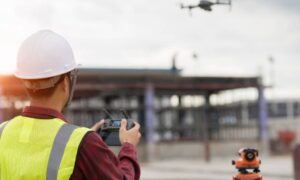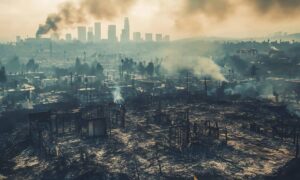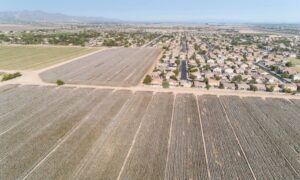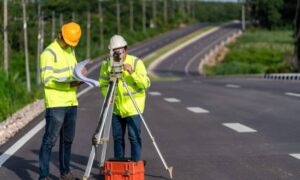
Northern Utah woke up to soaked streets, washed-out slopes, and standing water after one of the wettest weekends on record. For surveyors, that means one thing — an all-out rush to document what changed. A drone survey has suddenly become the go-to tool for capturing flood damage, slope movement, and shifting terrain before the next storm rolls in.
When more than five inches of rain hit the Wasatch Front between October 4 and 6, 2025, the ground simply couldn’t keep up. Ogden saw clogged drains, small landslides near the foothills, and backyard flooding from Clearfield to Roy. While most residents focused on cleanup, surveyors grabbed their drones and got to work mapping the aftermath.
When the Sky Clears, the Real Work Begins
Storms like this don’t just leave puddles — they change the land itself. Soil shifts. Drainage patterns twist. Retaining walls lean ever so slightly. For engineers and builders, that’s a serious problem, because one inch off on elevation can mean thousands in repair costs later.
That’s where aerial mapping steps in. A drone survey lets surveyors capture high-resolution imagery of entire neighborhoods in a fraction of the time it would take on foot. Within a day, they can produce detailed elevation models that show where runoff carved new channels or where driveways now slope the wrong way.
In a place like Ogden — where foothills meet flatlands — these updates are more than helpful. They’re essential. Builders can’t resume grading or foundation work until they know if stormwater is draining correctly. Insurance adjusters, too, rely on updated survey data to support claims.
Why Everyone’s Talking About Drone Surveys Right Now
After this record rainfall, surveyors report a sharp rise in calls for post-storm mapping. Contractors need proof that drainage systems were built to plan. Homeowners need to show that their lots didn’t cause runoff damage.
And local agencies? They’re racing to update data for the county’s 2025 pre-disaster mitigation plan, which depends on recent elevation mapping.
The beauty of drone technology is how quickly it delivers a snapshot of reality. Aerial photos stitched into a 3D surface model show every rut, ridge, and gully. Surveyors overlay this with old contour data to measure just how much the terrain changed. In some Ogden neighborhoods, slopes shifted by several inches — enough to redirect stormwater and overwhelm culverts.
What Local Surveyors Are Capturing Right Now

Drive through Ogden this week and you might spot drones buzzing above construction sites or drainage channels. They’re not hobby flights — these are certified professionals documenting change.
Here’s what they’re focusing on:
- Low Points and Driveway Grades: Is water still flowing toward the street, or is it pooling behind homes?
- Culverts and Drainage Swales: Sediment buildup or blockages can cause repeat flooding if not corrected.
- Slope Stability: Hillsides near the Wasatch foothills show tell-tale erosion scars.
- As-Built Checks: Builders are confirming that finished elevations still match approved plans.
- Volume Calculations: Drones measure how much soil washed away or piled up — data that helps both cleanup crews and insurers.
Every flight gives Ogden’s surveyors a clearer picture of how the landscape has changed — and how to prevent repeat damage.
The Human Side of the “Drone Survey Dilemmas”
While technology helps, it’s not without hiccups. Some property owners worry that drones flying overhead invade privacy. Others assume the data is instant, not realizing it still takes hours of ground control and processing to produce accurate 3D maps.
Then there’s coordination. After a storm, multiple teams may request aerial data at once — engineers, contractors, insurance reps — each with slightly different needs. Surveyors juggle priorities to keep everyone updated.
One local surveyor jokes, “We’re racing the next cloud.” That sums it up. When the next rain is only days away, every drone flight counts.
Still, most residents are grateful. Quick-turn drone mapping helps verify slope conditions before more rain hits. It gives peace of mind — and sometimes proof — that their property is safe.
How a Drone Survey Helps You as a Property Owner
If you’re in Ogden or anywhere, here’s why this matters. After heavy rainfall, the smallest change in grade can create lasting issues. Standing water, cracked sidewalks, and slow drains might seem minor now, but they often hint at deeper shifts underground.
A drone survey captures today’s conditions in full detail — something you can’t see with a phone photo. You’ll get:
- Orthophotos (aerial images corrected for scale)
- Elevation maps that show runoff paths
- Visual proof for contractors or insurance adjusters
For homeowners planning any repair, landscaping, or new build, this data is gold. It shows exactly where water goes — and where it shouldn’t.
Drone Surveys and Traditional Land Surveying Work Together
It’s worth noting that drones don’t replace licensed land surveyors. They enhance them. Drone pilots capture fast, broad data; surveyors use ground control points to anchor that data to real-world coordinates. The result: centimeter-level accuracy that meets professional standards.
In Ogden, many licensed surveyors double as FAA-certified drone pilots. They use software to merge aerial imagery with GPS data, producing clean CAD files ready for engineering or permitting.
The combination of old-school fieldwork and new aerial tech is what makes today’s surveys so powerful — and why Ogden’s post-storm recovery is moving faster than in past years.
Looking Ahead: Mapping Before the Next Storm
Experts say more storms like this could be on the horizon as Utah’s weather patterns continue to shift. That’s why the smartest step is to document your property now, while it’s still accessible and dry.
Order a drone survey if you notice:
- New puddles or soil settling after rain
- Erosion near driveways or retaining walls
- Changes in drainage between you and your neighbor’s lot
A current aerial model gives you a clear baseline. If another storm hits, you’ll have the proof and data needed to plan repairs quickly.
Conclusion:
The Wasatch Front may be drying out, but the rush to map its soaked landscape is far from over. Surveyors are flying drones from dawn till dusk, capturing the clues nature left behind.
For homeowners and builders, those images mean faster recovery, fewer disputes, and smarter planning.
So before the next rainstorm rewrites your property’s story again, consider scheduling a drone survey. It’s fast, accurate, and could save you thousands — or at least a few sleepless nights — the next time the clouds roll..





